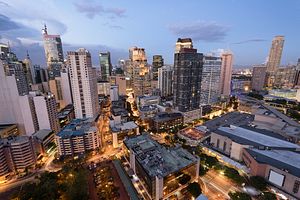For the past five years, the Philippines, which long lagged behind faster-growing Asian economies like Thailand, Malaysia, Vietnam, and Indonesia, has posted some of the highest annual growth rates in the region. Although the Philippines’ boom has not received as much attention from investors and the international media as one might have imagined, the numbers are impressive. ANZ Bank projects the country to grow by 6.1 percent in 2016. In 2014, the country’s economy also grew by over six percent, and in 2015 it grew by 5.8 percent, according to World Bank data.
There are several reasons for the boom, which has occurred on the watch of President Benigno Aquino III. The potential for real peace in the southern Philippines has boosted the economy of Mindanao, with aid and investment pouring in to the island. Aquino’s high-profile efforts, early in his term, to combat corruption, made an impact on some investors. Although the president’s anti-corruption campaign has not quite lived up to its promises, it did help make investors reconsider the country as a destination. The Philippines has risen in Transparency International’s Corruption Perceptions Index on Aquino’s watch, and investment and sounder fiscal policies have paid off, allowing the Philippines to borrow at better rates. The country’s debt is now ranked as investment or above-investment grade by Moody’s, Standard and Poor’s, and Fitch.
Still, in 2016 the Philippines face several major challenges, all of which will be inherited by Aquino’s successor after this spring’s presidential election. The Philippines remains one of the most vulnerable countries in the world to climate change, and the government has not demonstrated that it can effectively handle the aftermath of another devastating typhoon like 2013’s Typhoon Haiyan. Tension with China is rising, and could spike later this year with the results of the Philippines’ South China Sea claim currently being heard in The Hague. China has refused to recognize the tribunal’s power, but a result in The Hague that goes against Beijing’s claims in the South China Sea could well lead to a strong show of force by China. In fact, Chinese leaders already have made clear that China will, if anything, be even more assertive in the South China Sea this year than last. Beijing reportedly is ready to deploy a new “monster” coast guard ship in the South China Sea, a boat that is the largest coast guard vessel in the world. The ship seems more like a warship than a coast guard vessel. According to The Diplomat, the monster “appears to be first and foremost a coercive instrument for such encounters and will help to advance China’s territorial claims in the South China Sea.”
Some of the leading contenders for the Philippines presidency, like Davao mayor Rodrigo Duterte, have limited experience in foreign affairs. Their inexperience could make any potential crisis with China worse, and might embolden Beijing’s actions in the South China Sea.
The Philippines’ economy also still faces serious challenges, revealing structural problems that persist through the end of the Aquino era. The country’s physical infrastructure still lags badly behind those of competitors like Malaysia, Thailand, and Singapore, and investment in Mindanao’s infrastructure could be undermined if the peace process fails. The education system, although capable of producing English-speaking graduates, still does not produce enough skilled workers for the country to move into higher-value industries, and unemployment remains stubbornly high in regions, in part because of the Philippines’ substantial birth rate. Corruption continues to cut into growth, and one of the leading presidential candidates, current Vice President Jejomar Binay faces a wide range of corruption allegations that could make him an unlikely figure to continue Aquino’s anti-corruption campaigns.
In addition, though a lasting peace in the south appears near, serious obstacles remain. Extremist groups, some pledging allegiance to the Islamic State, appear determined to puncture a permanent cease-fire in the south. These groups disdain the Moro Islamic Liberation Front (MILF), the biggest rebel group in the south, for entering peace negotiations with the government. The Philippines’ legislature still has not passed the Bangasmoro Basic Law, the legislation critical to devolving political and economic powers to the south—and to making the peace deal stick. If the legislature does not pass the law by February, the proposed legislation could easily become a major topic in the final days of the presidential campaign, which might lead candidates to embrace major changes to the Law that would undermine the entire peace process.
The May 2016 general election itself could further undermine growth. Philippine general elections have tended to be unruly and bloody affairs, and the already-combative campaign could wind up harming the legitimacy of the ultimate winner. Senator Grace Poe, who appeared to be the front-runner last year, has been prohibited from running by the election commission, which held she has not been a citizen of the Philippines long enough to be a presidential candidate. The Philippines’ top court is scheduled to decide on Poe’s candidacy the week of January 19, and if Poe is disqualified, many of her supporters might refuse to recognize whoever wins the election. If twenty to thirty percent of the public, the current level of Poe’s support, does not accept the results of the election, the Philippines could be in for serious turbulence.
Joshua Kurlantzick is a fellow for Southeast Asia at the Council on Foreign Relations. This post appears courtesy of CFR.org.
































